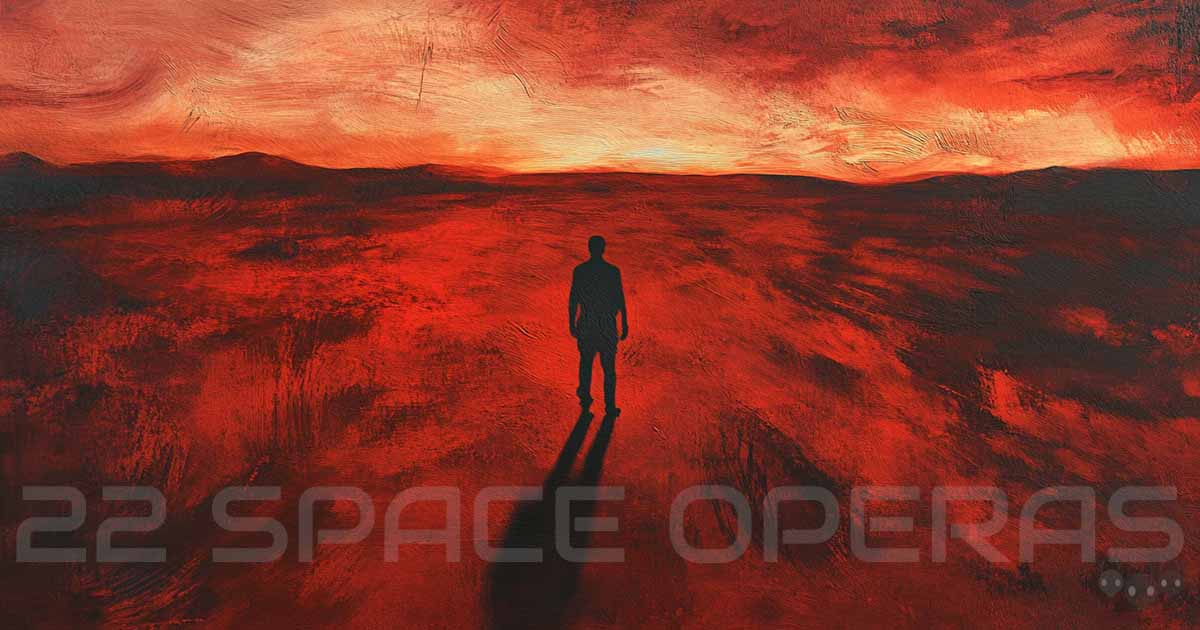The Top 22 Space Opera Science Fiction Series Published Before 2001
Explore 22 influential space opera classics from 1901-2001, including Dune, Foundation, and Ender's Game. Discover the genre's evolution from pulp roots to beloved sci-fi staple.

Space opera is a popular subgenre of science fiction that typically features large-scale conflicts, interstellar travel, and fantastical elements. Essentially, it is everything science fiction fans adore.
As a genre, space operas customarily draw inspiration from classic epics and myths, creating sweeping narratives that explore themes of heroism, adventure, and the human condition in the context of a vast and wondrous universe.
What is a Space Opera?
The term "space opera" was coined in 1941 by Wilson Tucker in an article in "Le Zombie," a science fiction fanzine. Tucker used the term derisively to describe what he saw as formulaic and melodramatic science fiction stories.
Despite its initial negative connotations, space opera has become a beloved and enduring subgenre, captivating readers and viewers with its grand scale and imaginative storytelling.
One of the earliest examples of space opera is George Griffith's "A Honeymoon in Space" (1901). This novel, which features a young married couple exploring the solar system and encountering various alien races, was a prototype for many future space operas.
Another influential early work is Edgar Rice Burroughs' "A Princess of Mars" (1912), which introduced the now-classic trope of a human hero saving a princess on an alien planet.
E.E. "Doc" Smith's "Lensman" series, which began with "Triplanetary" in 1934, is considered to be the first space opera with a genuinely galactic scale, with the fate of billions of years of life decided in the course of six books. The "Lensman" series had a profound influence on countless stories that followed and is thought to be the original inspiration for DC's "Green Lantern" character.
Now that we have had a little backgrounder let's dive into the important stuff.
22 Space Operas Published or Released Before 2001
Now that we have had a little backgrounder let's dive into the important stuff.

No. 1. Dune by Frank Herbert (1965): A sprawling epic set on the desert planet Arrakis, where political intrigue, ecological disaster, and messianic prophecy collide. The novel explores the complex relationship between humanity and its environment and the dangers of political power and religious fanaticism. "Fear is the mind-killer," writes Herbert, a line that has become iconic in science fiction.
Watch Dune and Dune: Part 2 on Amazon Prime.
No. 2. Hyperion by Dan Simmons (1989): A complex and philosophical tale of seven pilgrims on a journey to the planet Hyperion, where they encounter a terrifying creature known as the Shrike. The novel draws inspiration from Chaucer's Canterbury Tales, with each pilgrim telling their own story, which intertwines with the others to create a rich and multifaceted narrative.
The entire Hyperion series is available on Amazon (affiliate).
No. 3. Ender's Game by Orson Scott Card (1985): A coming-of-age story about a young boy trained to become a military commander in humanity's war against an alien race. The novel explores themes of childhood, morality, and the ethics of war, raising questions about the cost of victory and the nature of empathy.
Watch Ender's Game on Amazon Prime.
No. 4. Foundation by Isaac Asimov (1951): This is a classic work of science fiction that explores the fall of a galactic empire and the efforts of a group of scientists to preserve knowledge and rebuild civilization. The novel introduced Asimov's concept of "psychohistory," a fictional science that can predict the future course of human history.
Watch the Foundation Apple TV series on Amazon Prime.
No. 5. Starship Troopers by Robert A. Heinlein (1959): This controversial novel examines war, duty, and citizenship themes in a militaristic future society. The book has been praised for its action-packed narrative and its exploration of political philosophy, but it has also been criticized for its militaristic and arguably fascist overtones.
If you're a Starship Troopers fan, you might enjoy the article "Battle Armor, Cyberwarfare, and Nano Tech in Science Fiction & Real Life."
No. 6. A Fire Upon the Deep by Vernor Vinge (1992): A mind-bending story about a group of humans who crash-land on a planet with a medieval level of technology and become embroiled in a conflict with a powerful alien intelligence. The novel explores the concept of "zones of thought," regions of space where different levels of technology and intelligence are possible.
At the time of writing, this book was free on Kindle (affiliate)
No. 7. Neuromancer by William Gibson (1984): A seminal cyberpunk novel that helped define the genre, with its gritty depiction of a dystopian future and its exploration of artificial intelligence and virtual reality. The book introduced the term "cyberspace" and has had a profound influence on science fiction and popular culture.
Neuromancer is available on Amazon (affiliate).
No. 8. Snow Crash by Neal Stephenson (1992): A postmodern cyberpunk adventure that blends virtual reality, Sumerian mythology, and pizza delivery into a wild, satirical ride. The novel explores themes of language, information, and the nature of reality in a fast-paced and often humorous narrative.
This book has one of our favorite characters —Hiro Protagonist who is a freelance hacker, and pizza delivery driver for the Mafia— and is available on Amazon (affiliate)
No. 9. The Forever War by Joe Haldeman (1974): This powerful anti-war novel follows a soldier through centuries of interstellar conflict, highlighting the psychological and social costs of war. The story draws on Haldeman's own experiences in the Vietnam War and offers a stark critique of militarism and the dehumanizing effects of combat.
When this article was written, The Forever War was available for free on Kindle (affiliate)
No. 10. A Deepness in the Sky by Vernor Vinge (1999): A prequel to A Fire Upon the Deep, this novel explores the complex relationship between two alien races and the humans who become caught in their conflict—the novel delves into themes of technological advancement, cultural differences, and the dangers of first contact.
This Hugo Award winner was also free on Kindle Unlimited (affiliate) when we published this list.
No. 11. The Book of the New Sun by Gene Wolfe (1980-1983): A dense and challenging series of four novels that follow the journey of Severian, an apprentice torturer, through a far-future Earth. The series is known for its intricate world-building, philosophical depth, and unreliable narrator.
No. 12. Consider Phlebas by Iain M. Banks (1987): The first novel in Banks' Culture series, this space opera introduces a utopian society of humans and advanced artificial intelligences and explores the complexities of interstellar conflict. The book raises questions about morality, intervention, and the nature of consciousness.
No. 13. Use of Weapons by Iain M. Banks (1990): This is another Culture novel delving into the moral ambiguities of war and intervention through the story of a conflicted agent with a dark past. The book features a non-linear narrative structure and explores the psychological impact of violence and trauma.
No. 14. Excession by Iain M. Banks (1996): This Culture novel explores the implications of encountering a powerful and enigmatic alien artifact that surpasses the understanding of even the most advanced civilizations. The story examines themes of curiosity, knowledge, and the limits of technology.
No. 15. The Player of Games by Iain M. Banks (1988): A Culture novel that follows a game player recruited to participate in a complex and dangerous game on an alien world. The story explores themes of competition, strategy, and the nature of culture.
No. 16. Look to Windward by Iain M. Banks (2000): This Culture novel explores themes of guilt, revenge, and reconciliation in the aftermath of a devastating war. The book features a unique blend of space opera and philosophical reflection.
No. 17. Revelation Space by Alastair Reynolds (2000): This is a sprawling space opera that spans millennia and features a diverse cast of characters, including humans, aliens, and artificial intelligence. The novel explores themes of technological singularity, transhumanism, and the search for meaning in a vast and indifferent universe.
No. 18. Chasm City by Alastair Reynolds (2001): A prequel to Revelation Space; this novel focuses on the decaying city of Chasm City and the mysteries surrounding a deadly plague. The story blends space opera, noir, and horror with a gritty and atmospheric setting.
No. 19. The Gap Cycle by Stephen R. Donaldson (1991-1996): This series of five novels follows the journey of Morn Hyland, a woman who is kidnapped and forced into slavery. The series is known for its dark and gritty tone, complex characters, and exploration of themes of trauma, survival, and redemption.
No. 20. Deathstalker by Simon R. Green (1995): The first novel in the Deathstalker series, this space opera follows the adventures of Owen Deathstalker, a nobleman framed for treason and forced to flee into space. The series is known for its fast-paced action, over-the-top characters, and satirical humor.
No. 21. A Princess of Mars by Edgar Rice Burroughs (1917): This classic novel tells the story of John Carter, a Civil War veteran who is transported to Mars and becomes embroiled in the planet's conflicts. The novel is a seminal work of space opera, with its imaginative world-building and its thrilling adventure story.
Check out the article "Strength and Compassion from John Carter."
No. 22. Triplanetary by E.E. "Doc" Smith (1934): The first novel in the Lensman series, this space opera introduced the concept of a galactic patrol that protects civilization from alien threats. The book is known for its vast scope, action-packed battles, and influence on later science fiction works.

